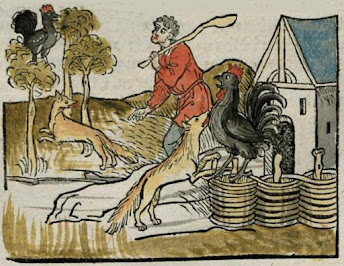Geoffrey Chaucer’s “The Canterbury Tales” is a collection of tales told by different characters. Among them, the most popular is The Nun’s Priest’s Tale. Here, the Priest tells a story, which may sound ordinary but contains some beautiful elements. It can be analyzed in various ways and readers will get many ideas to think about. Through the dialogues between animals, the author provided moral advice to the readers. One of the major elements of The Nun’s Priest’s Tale is the relation between man and wife.
The Nun’s Priest’s Tale talks about a rooster and his companion hens. The name of the rooster was Chauntecleer and his wife’s name was Pertelote. Although Chauntecleer had other wives, Pertelote was his favorite wife. We know that Chaucer was not interested in roosters and hens but provided some valuable advice to the readers. If we look at the relation between a man and his wife then we would see that it was an unequal relationship. The man or husband had great power but the woman or wife did not have any power. Very often, the husband would beat the wife, but she could not go to anyone and ask for justice.
The Nun’s Priest’s Tale gives a different description of the relationship between a husband and wife. At that time, husbands were considered to be manly while women were supposed to obey their husbands. When Chauntecleer tells Pertelote about his dream, Pertelote makes fun of it. She did not stop there. She told Chauntecleer that he was a coward and women do not want their husbands to be cowardly. Such behavior from a wife was very exceptional at that age. The social norms of that age required men to be strong and fearless and women to be less intelligent and obedient to men. However, Pertelote was not like other women of that age. She, on the contrary, had a great personality. She knew that Chauntecleer loved her very much so she could make fun of him. Although the poet presented a different kind of relationship between a husband and wife through Chauntecleer and Pertelote, it also gives the reader a new idea. Since Chauntecleer and Pertelote loved each other deeply, Pertelote could easily make fun of him. However, the matter of love was not much elaborated in the poem because in those days most of the marriages were arranged marriages. Ordinary people did not have a love marriage. This made the married life very monotonous and boring. The husband was supposed to go outside, work and earn money. The wife was supposed to stay at home, take care of the house, give birth to children after every one or two years and take care of them. Still, Chauntecleer and Pertelote loved each other deeply and Chaucer, with great skill, described this relationship.
For this reason, the idea of The Nun’s Priest’s Tale would seem very modern to us. At this age, the normal relationship between a husband and wife is quite similar to that of Chauntecleer and Pertelote. In a modern-day marriage, both husband and wife have equal rights. As a result, they treat each other like a friend.
Through this, Chaucer tried to show the discrimination in human society. There is less discrimination in the animal kingdom, but it was very much present in the society of Chaucer’s time. Women of that almost did not have any rights and very often the husbands would not listen to the advice of their wives. However, this poem shows a different picture. Upon observing his doom in his dream when Chauntecleer became anxious, Pertelote, instead of consoling him, makes fun of him.
Chaucer talked about marital bliss at a time when wives had no
rights. If we look at contemporary literature, we would find that it contains
lots of descriptions about love but not married life. They talked mostly about
love before marriage. Chaucer is an exception in this regard and for this one
should read The Nun’s Priest’s Tale.












